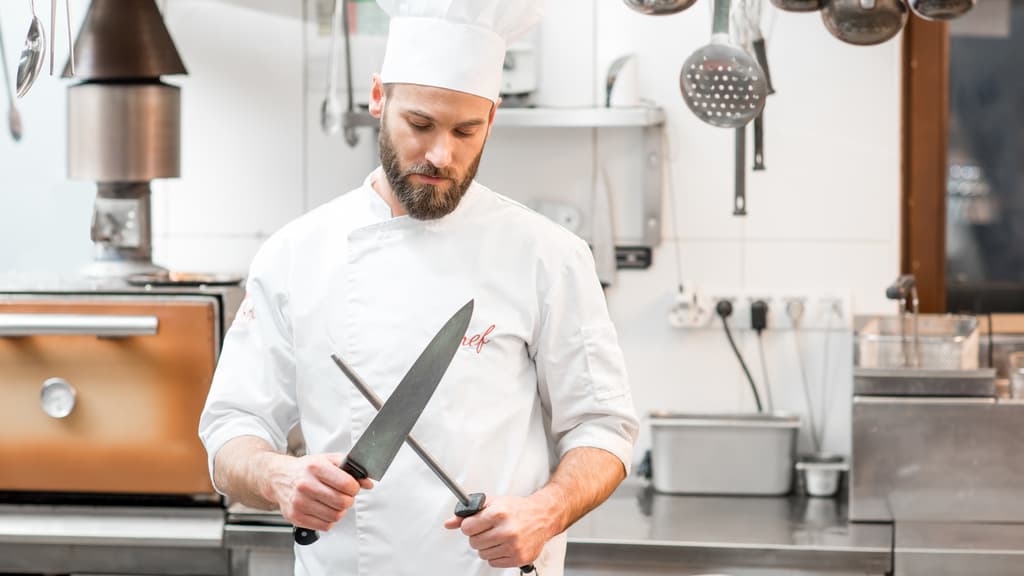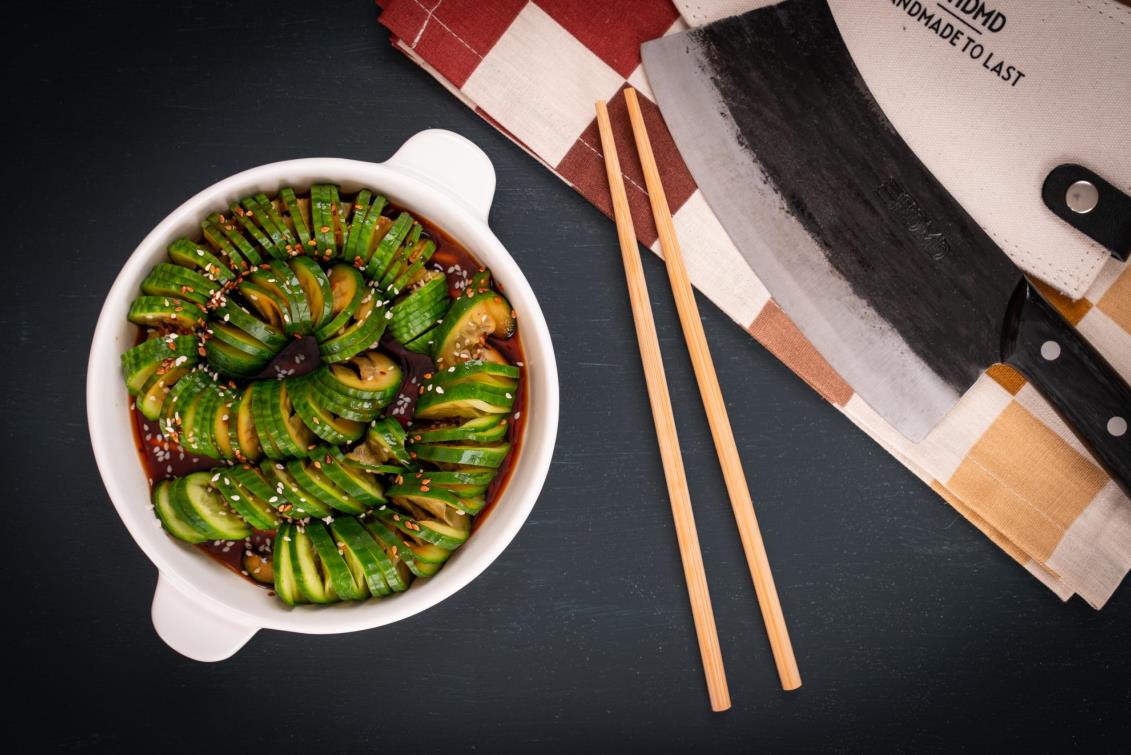Having a sharp knife at your service is always safer than a dull one. A sharp blade will cut through ingredients fast with ease and prevent accidents from occurring. While sharpening a knife is essential to achieve this, honing is what maintains the longevity of the sharp edge in a very convenient and fast way.
Unlike sharpening, honing a knife doesn’t precisely sharpen the blade but makes sure it remains that way. This article will cover the differences between sharpening and honing, demonstrate how to hone a knife, and provide tips on keeping your kitchen knives in good shape.
Table of contents
What honing does, and why it’s important?
Over time, the perfectly straight cutting edge created with the sharpening stone goes out of line at microscopic levels and may become dented. This causes the blade not to cut through ingredients the same way as it would before. Honing realigns the edge in its entirety and straightens it by wearing off trace amounts of metal.
Although honing doesn’t exactly work the same as sharpening, it’s essential to keep a knife in good shape. If you don’t want to sacrifice the sharpness of your knife, honing should be done often – it’s best to make it a habit.
Differences between honing and sharpening

To better understand the difference between honing and sharpening, we first need to look at how the edge becomes sharp in the first place.
Sharpening takes place by removing material from the blade with the grid of the whetstone to create a new, sharper edge. The newly created edge is similar to a “V” shape in most knives. The shape of the edge depends on the blade’s grind. It’s mainly either single or double beveled. See how to spot the difference between single and double beveled kitchen knives.
On the other hand, honing the blade doesn’t create a new edge. As you cut ingredients, the “V” edge will become irregular at microscopic levels. It won’t make a significant difference at first, but your knife will struggle to perform at its best.
Honing a knife puts the ragged edges in order, giving you a sharper edge without requiring the use of a whetstone. With the help of a honing rod, you will have more time to cut ingredients quickly before picking up a whetstone too soon.
If you were to sharpen a knife as often as honing, you would run out of a blade pretty quickly as sharpening removes more metal from the edge. That’s why honing is a convenient way to sustain a sharp edge.
Handpicked for you
True cutting power in the palm of your hand
How often should you hone a knife?
The same as sharpening, how frequently you need to hone a knife depends on usage. Suppose you’re using your kitchen knives as often as multiple hours throughout the day. You will undoubtedly want to hone them every other time you pick them up to have a sharp edge at all times.
Though it also differs from knife to knife and the type of steel used, we recommend honing at least once every two to three uses. This will keep the sharp edge in good condition without requiring a sharpening session shortly.
How to hone a knife?

Now that you know how big of an impact honing has in keeping the sharpness of a blade, here is how to hone a knife.
Firstly, you will need a honing rod. This is also known as sharpening steel or honing steel. Just as there are various ways of holding a knife, there are two different methods you can follow to start honing your kitchen knife.
First honing technique
- Hold the honing rod firmly in your non-dominant hand.
- Place the heel of the blade and stroke it through the tip.
- Follow the same routine for both sides evenly.
This is the most common way of honing a knife in the kitchen. You’ll see plenty of chefs doing this with their knives right before cutting. If you want to smooth out the edges to make sure the edge cuts perfectly every time, keep your honing rod close by to give the knife a few strokes before cutting.
Second honing technique
- Place the honing rod’s tip on a stable surface like a cutting board or towel.
- Secure the position of the honing rod with your non-dominant hand.
- Stroke the blade’s edge from the heel to the tip.
This is another approach to honing knives, and it’s a better way to do it if you’re cooking at home. Rather than honing your knife after using it a few times, doing it this way every other day will give you an easier time preparing meals for the family. Compared to the first technique, the downside to this is that you will need to hone the blades for longer. Give it about 25 to 30 strokes on each side, and you’re good to go.
Tips on honing a knife

Though it may sound simple enough, there are a few things that you need to get right to have an ideally honed edge. Here are some of the things to keep in mind when honing a knife.
Finding the right angle
Like sharpening with a whetstone, you’ll need to position the knife at the right angle. An easy way to do it is by placing it on the honing rod at 90 degrees and narrowing the angle until you get it right. If you’re unsure about the positioning, know that most western chef’s knives have 20 to 25-degree angles set by the manufacturers. The angle is smaller at about 15 degrees for Japanese knives.
Not quite sure about the knife’s angle? Start at a more steep curve and widen it out while you hone the blade to feel for the right angle.
Checking if everything is correct
An excellent way to understand if you’re correctly stroking the blade is by feeling and hearing the edge. You won’t be able to stroke the blade as smoothly when the angle is wrong. Additionally, the sound from the blade and the rod’s also won’t be consistent on both sides. Watch out for these, and you’ll have a perfectly honed edge at the end.
Pressure and other things to beware
When stroking the blade, avoid putting too much force into it. With light pressure, let the weight of the knife do its work. The force should be similar to shaving hair with a razor blade.
Do the strokes evenly on each side. Honing one side more than the other will shift the edge to one side, later resulting in inconsistent cuts.
Hone the blade entirely, starting from the heel to the tip. Honing a portion of the blade and ignoring other parts will also result in inconsistent cuts.
Keep your elbow and wrist locked throughout the honing process. This helps retain the same angle as you hone the blade from the heel to the tip.
Different types of honing rods
Honing rods come in various varieties of shapes, sizes, and grits. Although most will work just fine on any kitchen knife, it might be better to choose a specific type of rod that suits the knife you’re honing.

Length
There is a wide variety of honing rod lengths to choose from, just like knives. The lengths range between 8 and 14 inches, with the most common honing rods being around 12-inches. The longer the blade, the lengthier your honing rod should be.
Material
Most honing rods are made from chromium-plated steel, but ceramic and diamond are also used. If your knife’s blade is made from harder steel like high-carbon stainless steel, get a sturdier honing rod like ceramic or diamond. Because these are a lot harder than steel, they won’t wear off as quickly. Additionally, ceramic and diamond honing rods can also sharpen the edge by removing more metal.
Shapes
Most honing rods are round, but they can also be oval. The oval-shaped honing rods give more surface area to work on and are primarily found in either ceramic or diamond honing rods.
Grits
Depending on the grit, the honing rods can actually sharpen the blade than just realigning the edges, acting as a tool more than just for maintenance. Anything above 1,000 grit will slowly start sharpening the blade, especially if it’s ceramic or diamond. Take a look at the packaging to see the grit. Most honing rods are between 400 and 800 grit but can be up to 3,000.
Other things you can do to keep a knife in good shape
Sharpening and honing are essential to keeping a knife in good shape, but these aren’t all you can do. Utilizing the following along with a regular sharpening and honing routine can help you keep a knife in excellent condition.
- Cut ingredients on proper surfaces like cutting boards. Avoid hard or metal surfaces like stone or aluminum. This includes glass cutting boards.
- Don’t leave your knives in the sink waiting to be washed, and dry the blade before leaving it unattended.
- Don’t throw your knives in the dishwasher and wash them by hand.
- Always dry your knife fully before putting it away.
- Store your knives correctly to prevent damages and accidents.
Honing your knife as often as you use them, sharpening every other month, and applying the basic care methods mentioned above will make it last longer. A good kitchen knife should be there for decades. Go to our store to find the knife that will accompany you for a long time.













